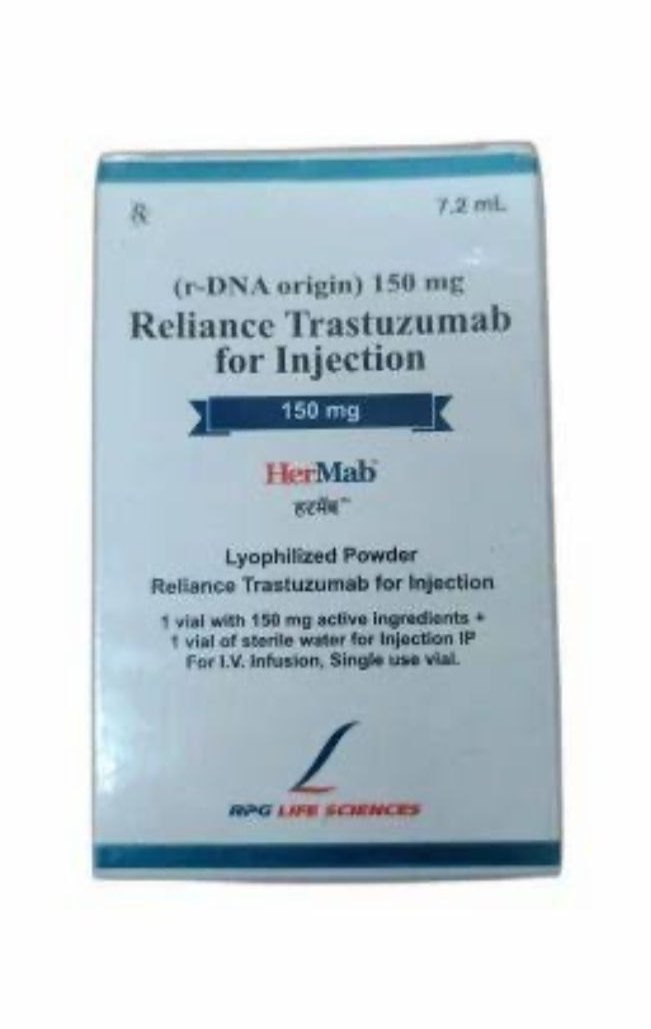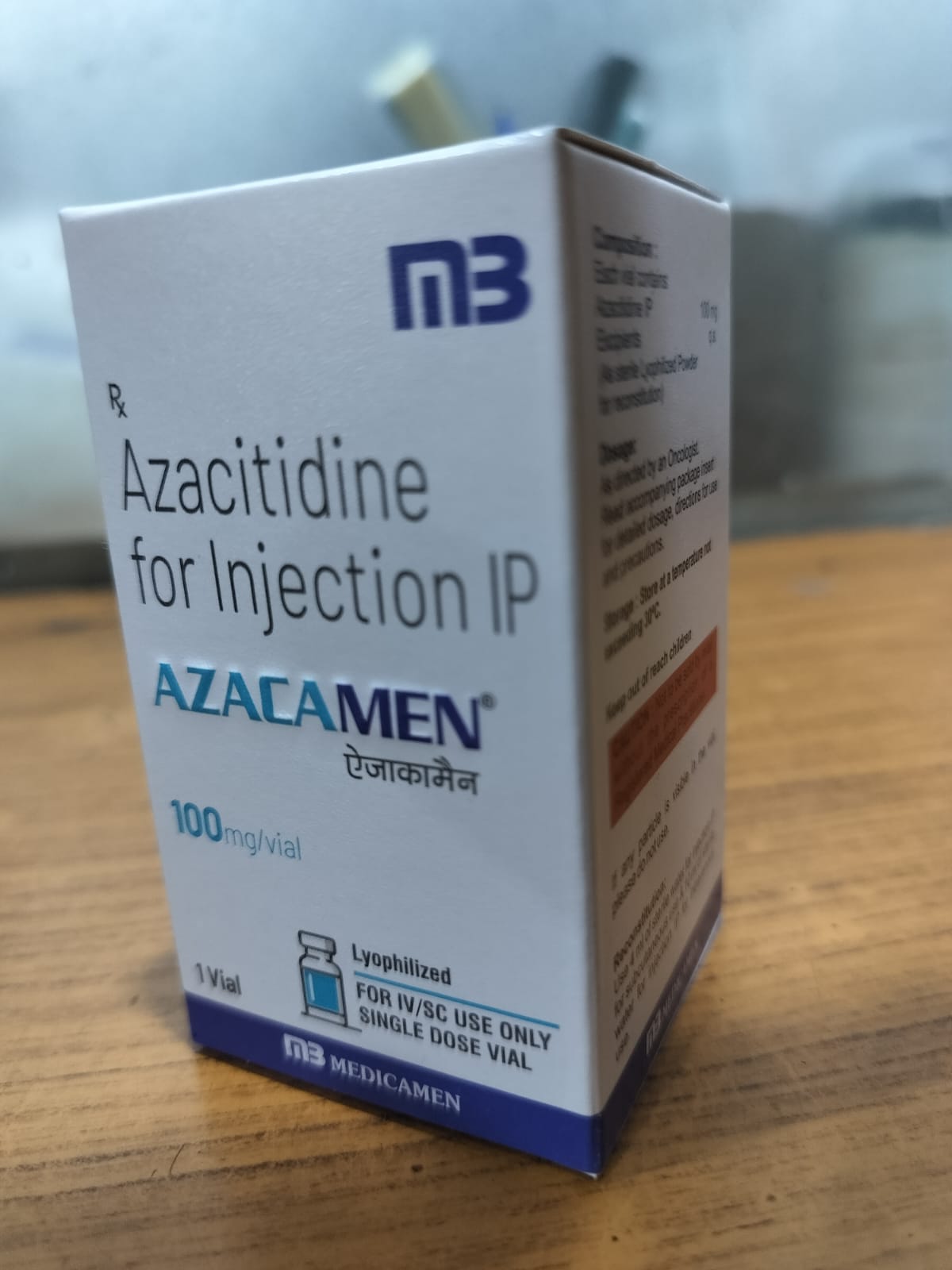Product Introduction:
Hermab is an anti-HER2 monoclonal antibody therapy used in HER2-positive cancers. It is available in 150 mg single-use and 440 mg multi-dose vials and is manufactured by Reliance Life Sciences. It is typically administered via intravenous infusion.
Uses (Indications):
Trastuzumab is specifically designed for patients with tumors that overexpress HER2. Major indications include:
-
HER2-Positive Metastatic Breast Cancer – alone or in combination with paclitaxel or docetaxel
-
HER2-Positive Early Breast Cancer – adjuvant setting with chemotherapy (e.g., AC-T or TCH regimens)
-
Neoadjuvant Therapy – before surgery in HER2-positive locally advanced breast cancer
-
HER2-Positive Metastatic Gastric or Gastroesophageal Junction Adenocarcinoma – in combination with cisplatin and 5-FU/capecitabine
-
HER2-positive recurrent breast cancer – as monotherapy or maintenance
-
Investigational uses in endometrial, ovarian, and bladder cancers with HER2 overexpression
Storage Instructions:
-
Store vials at 2°C to 8°C in the refrigerator
-
Do not freeze the reconstituted or unreconstituted product
-
Protect from light and moisture
-
After reconstitution, 150 mg vial must be used immediately; 440 mg vial (with bacteriostatic water) can be stored for up to 28 days at 2°C–8°C
-
Discard if solution is cloudy or discolored
How It Works (Mechanism of Action):
Trastuzumab is a recombinant humanized monoclonal antibody that binds to the extracellular domain of the HER2/neu receptor.
-
HER2 is overexpressed in 20–30% of breast cancers and associated with poor prognosis
-
Trastuzumab inhibits dimerization of HER2 receptors, blocking downstream signaling pathways (MAPK, PI3K)
-
It also triggers antibody-dependent cellular cytotoxicity (ADCC), recruiting immune cells to destroy HER2-expressing cancer cells
-
The result is reduced cell proliferation and increased apoptosis
Side Effects:
Common Side Effects:
-
Fever, chills, and flu-like symptoms (especially first infusion)
-
Nausea and vomiting
-
Headache
-
Fatigue
-
Diarrhea
-
Skin rash
Severe Side Effects:
-
Cardiotoxicity – heart failure, decreased left ventricular ejection fraction (LVEF)
-
Infusion-related reactions – bronchospasm, hypotension, anaphylaxis
-
Pulmonary toxicity – interstitial lung disease, pneumonitis
-
Neutropenia and increased infection risk (with combination therapy)
-
Liver enzyme elevation and hepatotoxicity
-
Serious allergic reactions – rare but possible
Dosage (Typical Recommended Dose):
For Breast Cancer (IV infusion):
-
Loading dose: 8 mg/kg IV over 90 minutes
-
Maintenance dose: 6 mg/kg every 3 weeks over 30–90 minutes
For Gastric Cancer (IV infusion):
-
Loading dose: 8 mg/kg on day 1
-
Maintenance dose: 6 mg/kg every 3 weeks until disease progression or toxicity
Note: Dose should be adjusted for body weight and cardiac function should be assessed before and during therapy.
Method of Administration:
-
Reconstitute lyophilized powder with sterile water or bacteriostatic water (depending on vial size)
-
Further dilute with 250 mL of normal saline (0.9%) for IV infusion
-
Do not use dextrose-containing solutions
-
Administer first dose over 90 minutes, subsequent doses can be given over 30 minutes
-
Monitor vitals closely during the first infusion
Precautions:
-
Baseline and periodic echocardiograms (LVEF) are required to monitor cardiac function
-
Not recommended for patients with pre-existing heart failure or recent MI
-
Avoid in pregnancy – known to cause oligohydramnios and fetal harm (Pregnancy Category D)
-
Use effective contraception during and for at least 7 months after last dose
-
Caution in patients with pulmonary conditions – risk of interstitial pneumonitis
-
Discontinue immediately if patient develops severe infusion reactions or significant cardiac dysfunction
Drug Interactions:
-
Anthracyclines (e.g., Doxorubicin) – increases risk of cardiotoxicity; avoid concurrent use
-
Cyclophosphamide and platinum agents – additive myelosuppression
-
Paclitaxel/Docetaxel – commonly used in combination, monitor for additive toxicities
-
Live vaccines – avoid during treatment
-
CYP450 interactions are minimal, as Trastuzumab is a biologic
Allergies (Warnings for Allergic Reactions):
-
Contraindicated in patients with known hypersensitivity to Trastuzumab or murine proteins
-
Hypersensitivity symptoms may include fever, chills, rash, hypotension, or angioedema
-
Emergency resuscitation equipment should be readily available during infusion
-
Patients should be pre-medicated if prior reactions occurred
Overdose Information:
-
No specific antidote for Trastuzumab overdose
-
Symptoms may include cardiac dysfunction or severe infusion reactions
-
Supportive management includes monitoring cardiac status, fluid/electrolyte management, and symptomatic care
-
Hospitalization may be required in severe cases
Missed Dose Instructions:
-
If a scheduled dose is missed, administer as soon as possible
-
Do not double the next dose
-
If the interval between doses is >1 week, resume with loading dose (8 mg/kg)
-
Always consult the treating oncologist before resuming therapy
Additional Notes:
-
Trastuzumab is a HER2-targeted biologic, not a traditional chemotherapy drug
-
Regular monitoring of HER2 status (via IHC or FISH) is essential before initiating therapy
-
Cardiac monitoring is mandatory due to potential for reversible or irreversible heart failure
-
Trastuzumab has revolutionized survival outcomes in HER2-positive breast cancer
-
Hermab by Reliance Life Sciences is a cost-effective Indian biosimilar, widely used in oncology centers
-
Do not interchange IV and SC formulations without consulting the oncologist



